
by Victoria Silverwolf
The Heart asks Pleasure – first –
And then – Excuse from Pain –
And then – those little Anodynes
That deaden suffering –
–Emily Dickinson
Our host has already provided a powerful and heartfelt essay on the horrific Birmingham church bombing that occurred this month. Along with shock and sorrow, we should share a conviction to oppose the racial inequality which leads to such evils.

Members of the Congress of Racial Equality march in Washington, D. C., on September 22
It is understandable that many people, myself included, will seek some form of distraction from these troubling times. For most Americans, that often means television.
The American Broadcasting Company, the youngest of the three big networks, premiered new series this month. Of most interest is The Outer Limits. Watch for reviews of this science fiction anthology show from one of our fellow Galactic Journeyers soon.

Those who prefer tales of suspense may wish to watch The Fugitive, starring David Janssen as a physician wrongly convicted of murdering his wife. He escapes from custody during a train wreck, and tries to track down the real killer while eluding the police.

Young viewers, and those who enjoy unrealistic sitcoms, are likely to tune in for The Patty Duke Show. The talented young actress, best known for her Oscar-winning role as Helen Keller in The Miracle Worker, has a double role as a pair of identical cousins with opposite personalities. It's a ridiculous premise, but may appeal to folks in search of lighthearted amusement.

The American popular music charts were dominated by two very different hit songs. Earlier in the month, we had the silly but catchy little number "My Boyfriend's Back" by the Angels.

More recently, a remake of Tony's Bennet's 1951 hit Blue Velvet by crooner Bobby Vinton reached Number One. Vinton's version first appeared on the album Blue on Blue, containing only songs with the word blue in the title. When Blue Velvet became a smash hit, the album quickly reappeared with a new cover and a new title.

Of course, my favorite form of escapism is reading imaginative fiction. Let's see if the latest issue of Fantasticprovides the kind of thing I'm looking for.

The Screen Game, by J. G. Ballard

We return to Vermillion Sands, a desert resort for the wealthy and the artistic, which has supplied the background for several of the author's stories in the past. The narrator is a painter. He accepts a commission to produce a large number of backdrops to be used during the making of an avant garde movie. The filming is to take place at the mansion of a wealthy man whose mother died under mysterious circumstances. He discovers a woman inside a number of screens he has painted with signs of the zodiac. Her hobby is placing jewels on the bodies of venomous insects. Secrets are revealed, and tragedy follows.
This story is full of striking images. It proceeds with the inevitability of a Greek play. The author's characters are larger-than-life archetypes. Cover art and interior illustration by the great Emsh perfectly capture the tale's strange beauty and brooding sense of mystery. Not all readers will care for the decadent aesthetes who populate Vermillion Sands, but I found the story compelling. Five stars.
The Wolf Woman, by H. Bedford-Jones

This month's reprint, taken from the pages of the August 1939 issue of Blue Book, features the time-viewing machine we encountered in last month's Fantastic. Here it is used to spin a tale set in ancient India, at a time of war between Aryans and Dravidians. Dravidians force the ruler of the Aryans to swear that her people will not emerge from their stronghold. In return, the Dravidians will refrain from attacking them and supply them with food. The ruler slyly avoids swearing that she will not leave her castle. She embarks on a one-woman mission to slay the ruler of the Dravidians, with the help of superstition and a tame wolf.

Although the introduction by science fiction historian Sam Moskowitz claims that this story is part of werewolf literature, in fact it provides a completely rational explanation for the myth of lycanthropy. The heroine merely uses trickery to convince her enemies that she has the power to become a wolf. The author's version of the remote past is more romantic than realistic. By the end of the story, the characters act in ways only found in sentimental pulp fiction. Two stars.
King Solomon's Ring, by Roger Zelazny

This story takes the form of a letter written by the narrator to a woman with whom he shares a checkered past. The narrative is full of flashbacks and foreshadowing, making the complex plot difficult to follow. In brief, a man has a limited form of telepathy which allows him to communicate, at least partly, with aliens. He leaves a life of crime for a form of legal plunder, in which Earth corporations take advantage of the inhabitants of other worlds. An encounter with insect-like aliens leads to a strange transformation. Although it's not always clear exactly what's going on, the author's brisk, informal style holds the reader's attention. Three stars.
Let There Be Night, by Robert F. Young

A space traveler is marooned on a planet which is inhabited by aliens who are identical in every way to human beings, except for their language and culture. The planet has a large moon with natural features that closely resemble a scowling face. This is the god of the inhabitants. Their lives are spent trying to appease their angry deity. The spaceman sets himself up in the tradition of A Connecticut Yankee in King Arthur's Court, leading the people from simple farming to advanced technology. His only problem is that they refuse to purchase anything but necessities, due to their fear of the god. He decides to use the armaments he has aboard his spaceship to alter the face of the deity, with unexpected results.
As the synopsis above reveals, this story is full of implausible happenings. It is better read as a fable than as serious speculation. The author is obviously trying to say something about the way in which religion influences human behavior. What happens at the end may be too cynical for some readers. Two stars.
Mating Season, by Wilton G. Beggs

Fleeing an impending atomic war, human colonists journey to a distant planet. It turns out to be barely habitable. An alien disease devastates the population. By the time the story begins, there are only three survivors. A woman is dying from the disease, but her husband is immune to it. A teenage girl, born on the planet, is also immune. On a hunting expedition, the tensions among them reach a climax. This is an unrelievedly grim story. It has emotional power but is unpleasant to read. Two stars.
A Night with Hecate, by Edward W. Ludwig

The witch-goddess Hecate wakes from a long slumber to discover herself in the year 1997. The only reason she survives at all is because she has one remaining worshipper, an old man. Alone, he will not be enough to keep her alive, because construction equipment is about to destroy her altar. The mismatched pair spend the night seeking out another person to worship her. This is made nearly impossible by the fact that only those who believe in her can see her.
This blend of science fiction and fantasy takes place at a time when science and logic have nearly destroyed any sense of the magical. It reads like something Ray Bradbury might have written when he was in a particularly dark mood. Hecate is both alluring and terrifying, taking humans as either lovers or sacrifices. This ambiguity makes it hard to determine what the author really thinks about the war between rationality and fantasy. The narrative has a feverish, hypnotic quality. The macabre illustrations done by Lee Brown Coye in his unique style outshine the story itself. Three stars.

Fifty cents is a small price to pay for hours of release from the all-too-real terrors of the modern world. Take a Fantastic detour, and refresh your mind.
Tag Archives: J.G. Ballard
[May 27, 1963] A Clang of Doom? (New Worlds, June 1963)

by Mark Yon
One sad piece of news to start with this month. I have just found out that Science Fiction Adventures has published its last, with the May 1963 issue. I understand that sales were not what they used to be in its heyday. It is hoped that this may be a temporary measure, but previous history suggests to me that, sadly, this may be the end. [The latest Science Fiction Times seems to indicate that the cancellation is permanent (ed.)]

If this is part of a general trend, then it may explain some of the recent changes with New Worlds, including this month’s cover:
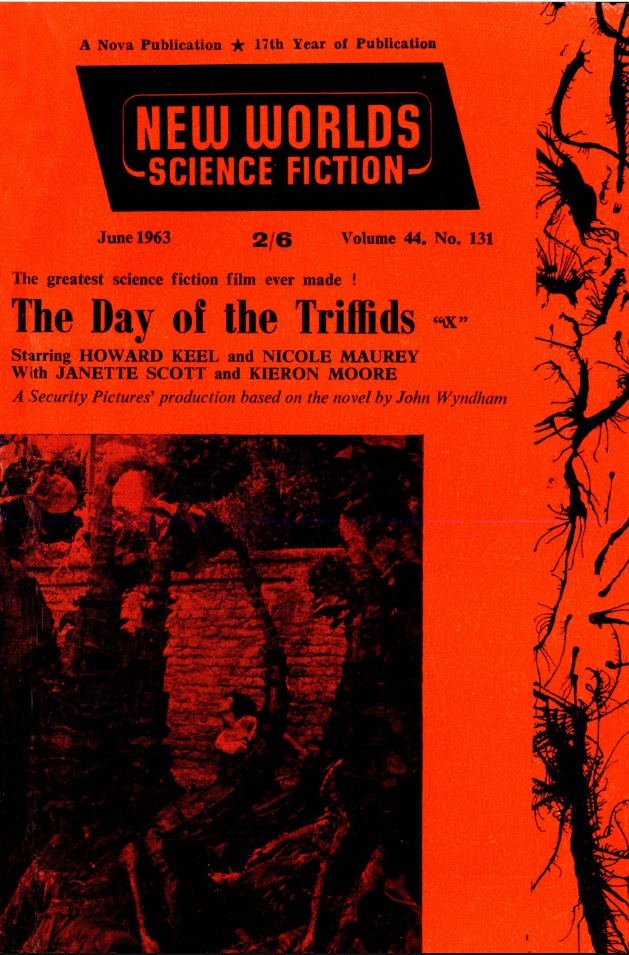
Well, at least this month’s cover doesn’t have the egregious spelling error last month’s issue had. We also have one large photo on the cover, which is an improvement on those of recent months without one.
However, it does raise issues – are things that bad that New Worlds needs the lure of a movie on its cover to raise sales? I think Editor John Carnell has tried to improve sales this month by putting a movie review head and shoulders above the fiction. (This also happened with the July 1962 issue as well, when the cover showed television programme Out of This World.)
More worryingly, with Mr. Carnell being distracted by such events away from New Worlds has he lost his focus on the magazine? I have, in recent months, raised worries about some of the recent changes, which now make sense. The use of Guest Editors over the last year may have given Mr Carnell space and time to sort things out, but I am still concerned that whilst this issue is full of experienced writers and magazine regulars, it the magazine is becoming less about the fiction and more about what is going on outside its pages.
Beer In The Wine Bottle, by Mr. John Ashcroft
This month’s guest editor is another unusual choice. Like Mr. Michael Moorcock, back in March, he is better known for his fiction outside of New Worlds. As the magazine profile suggests, Mr. John Ashcroft has had stories published in sister magazines Science Fantasy and Science Fiction Adventures, but is relatively unknown here.
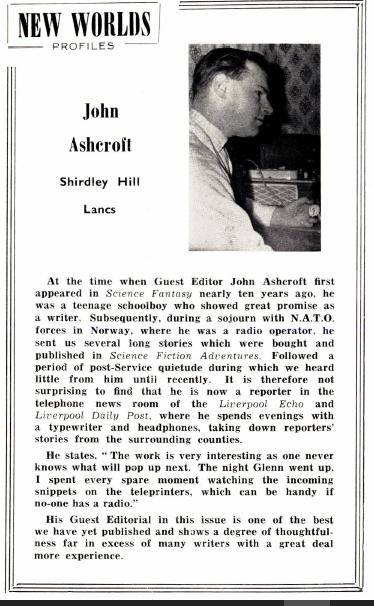
That’s a pretty big claim at the end of the profile, but the Editorial made a point that many s-f readers will appreciate: "Contemporary science fiction is generally more competently written; but it is more complacent." Mr. Ashcroft advocates that that old "sense-of-wonder" is important and that current writers need to raise their game.
From The-Old-Man-In-The-Mountain, by Mr. Joseph Green
I must admit I was not looking forward to Mr. Joseph Green’s novelette this month. As the third story of an unimpressive series (so far), albeit in a longer form, I was prepared to be underwhelmed. However, it is a pleasant enough tale of the increasingly mutual interaction between colonising humans and the hirsute aliens named Loafers, even if the Loafers remind me of Mr. H. Beam Piper’s Little Fuzzies, with added telepathy. In this tale it all turns a bit Midwich Cuckoo with a young Loafer abducted by an embittered human outsider, but, with teamwork from the humans and the aliens, unsurprisingly ends with all being well. A better effort than Mr. Green’s others in the series, if still rather unmemorable. Evidently the last in the series is in next month’s issue. 3 out of 5.

To the other stories.
End-Game by Mr. J. G. Ballard
By contrast, and like Mr. Brian Aldiss last month, this is a welcome return to New Worlds of an author who had moved on to a wider literary field. This is even better than Mr. Ballard’s last tale of consumer stress (The Subliminal Man, January 1963). End-Game is another typically Ballardian tale of isolation and emotional anguish, featuring an imprisoned man to be executed but at a time unknown to him. It becomes a psychological battle of wills between the condemned and his executioner, masked by a series of chess games that imply a fight between a police state and the individual. As with the best of Ballard, it is complex and intelligent, making me believe something that could happen behind the Iron Curtain. It even self-knowingly references Kafka! Not surprisingly, the best story in the issue. 4 out of 5.
Occupation Force, by Mr. David Rome
From another returning regular, Mr. Rome’s tale is quite different to his last (Meaning, December 1962). Occupation Force is a war story, telling of the uneasy relationship between a nuclear-weapon-wielding occupying army and the seemingly innocent oppressed "natives." In these times of campaigns for nuclear disarmament, it is a thought-experiment of a possibility that could also be relevant in 1963. Sadly, it is also short, predictable and, even with the attempt to shock through a downbeat ending, surprisingly forgettable. A lesser effort. 2 out of 5.
Dipso Facto, by Mr. Robert Presslie
Mr. Presslie’s return to New Worlds is also a disappointing effort. Even if I ignored the "poor, dumb natives" angle, this attempt to be humorous in a story of competitive eating and drinking is a long, long way away from the intelligence of similar stories, such as Mr. Poul Anderson’s Nicholas van Rijn tales. It fails pretty quickly. Also 2 out of 5.
Window On The Moon, by Mr. E. C. Tubb
And so to the last of this serial. Last month’s part ended with a couple of shocks – an explosion that destroyed the Royal Commission sent to the British Base, and the Americans who visited the Brits also mysteriously killed on their journey back to their base. This issue deals with the aftermath and gives us a cause for the strange happenings. I’m pleased to say that the US and British bases did not declare war on each other, and it is left to our hero, Felix Larsen, to resolve things. I did predict the villain of the piece a couple of issues ago, but this didn’t stop me enjoying this last part of "Brits in Space." Window on the Moon is a tale told with energy and enthusiasm, even though I felt that it didn’t know how to draw it all together at the end convincingly. Not quite as good at the end as in the earlier parts. It made me wonder what someone like Mr. Arthur C. Clarke would do with it. 3 out of 5.

Film Review: The Day of the Triffids, by Mr John Carnell,
The last part of the magazine is given over to stills and a commentary of this film I looked forward to seeing, back in July 1962, so it is odd to just now get to read a review. The good news is that, I understand, it has recently been released in the USA, so you will be able to see it yourselves. Fellow Traveller Ashley described it in detail back in July. Like her, I was a little disappointed at the differences between the film and Mr. John Wyndham’s fantastic novel, but here Mr. Carnell is more glowing in its fulsome praise, despite the concerns over its delay and production issues. According to the editor, even the author, Mr. John Wyndham, was rather impressed, despite the changes.

In summary, the June issue is, thankfully, another generally solid issue, but with the odd misstep. Not quite as strong as last month’s, but worthy of a read. Despite my concerns mentioned earlier over Mr. Carnell’s editorship, it must be said that the last couple of months have produced issues that have been both memorable and thought-provoking. For all of its faults, there is nothing else quite like New Worlds. I am rather feeling that I must make the most of magazines such as this, whilst I can. I fear that the writing might be on the wall…
[May 12, 1963] SO FAR, SO GOOD (the June 1963 Amazing)

by John Boston

On the June 1963 Amazing, the cover by Ed Emshwiller seems to portray humanity crucified, with photogenic fella and gal affixed to the front panels of computers, anguished expressions on their faces and slots cut in them like the holes in a computer punch-card. I guess they are mutilated, if not bent, folded, or stapled. This is done in the hyper-literal and slightly crude mode of Emsh’s Ace Double covers, which compares badly to the less literal but much more imaginative and better-executed work he is contributing to F&SF. Suffice it to say that Emsh has not displaced William Jennings Bryan as our nation’s leading purveyor of Crucifixion imagery. The cover illustrates Jack Sharkey’s two-part serial The Programmed People, on which I will defer until it’s finished next month.

Of the other stories, the longest and best is J.G. Ballard’s novelet The Encounter, a notable departure from his usual tone and attitude. Astronomer Charles Ward takes a position at a California observatory and meets Andrew Kandinski, author of The Landings from Outer Space, who claims to have met a Venusian visiting in (his, her, its) flying saucer, and is trying to spread the revealed word that Earth must abandon its space explorations. Kandinski is clearly suggested by George Adamski, author of Inside the Space Ships and others, who makes similar claims. But the similarity stops there, since Adamski appears to be an outright fraud, while Ballard’s Kandinski is a tortured character who actually believes his stories. Ward becomes fascinated and can’t stay away from him, with personally disastrous consequences when the extraterrestrials come again—or do they?
Ballard deftly preserves the ambiguity, and along the way amusingly notes in passing the variety and similarity of imagery among SF, UFO mania, and more commercial popular culture (the only job Kandinski can get is waiting tables at a space-themed restaurant called The Site Tycho). There is also a brief but telling riff on Jung’s theory of flying saucers as a manifestation of the unconscious in times of impending crisis, and a suggestion that Kandinski may prove to be one of the “mana-personalities of history.” There’s a lot going on here and it is purposefully not tied up neatly.
This is also one of Ballard’s most humane stories. In some Ballard stories—even very good ones like last year’s Thirteen to Centaurus—his characters are more like finely-made constructs, machined to serve the author’s argument, than actual human beings. By contrast, both Kandinski and Ward come across as genuine, flawed, and vulnerable people, and the story as less of an intellectual construct than much of Ballard. (Of course, that’s part of the construct, but let’s not follow that line of argument any further.) This is a story that will be worth coming back to. Five stars.
So: Amazing has justified its existence for one more month. What else is here, besides the serial? Three short stories, two of them very short indeed. Let’s take the longer one, Telempathy, by Vance Simonds, his first in the SF magazines. It’s a story that is best allowed to speak for itself, though unfortunately some length is required to get the full flavor. Here’s the beginning:

“Huckster Heaven, in Hollywood, set out to fulfill the adman’s dream in every particular. It recognized more credit cards than it offered entrees on the menu. Various atmospheres, complete with authentic decor, were offered: Tahitian, Parisian, even Afro-Cuban for the delectation of the Off-Beat Client. In every case, houris glided to and fro in appropriate native costume, bearing viands calculated to quell, at least for the nonce, harsh thoughts of the combative marketplace. Instead, beamish advertisers and their account executive hosts were plied so lavishly that soon the sounds of competitive strife were but a memory; and in the postprandial torpor, dormant dreams of largesse on the Lucullan scale came alive. In these surroundings, droppers of such names as the Four Seasons, George V, and the Stadium Club were notably silent.”
And it goes on like that. If one can push aside the layers of attitude and exhibitionism (a canoe paddle might do it—or maybe a sump pump would be more suitable), a story becomes visible. Everett says he’s got something that will precisely predict the reception of new products or advertising campaigns, which he calls Empathy, and which appears to consist of extra-sensory rapport with several very smart or insightful people, mediated through Everett’s mutant pet mongoose. So Cam the adman takes him to see his client Father Sowles, a Nehemiah Scudder-like figure whose campaign for high office Cam is fronting. The campaign goes into high gear based on Everett’s ultimate inside information, though Father Sowles complains that the message is being lost: e.g., “And what about the race mongrelizers? . . . Trying to subvert America with an Afro-Asian Trojan Horse!”
A lot of this is actually pretty funny, and it’s nice to see such explicit skewering of current politico-religious crackpottery. If Simonds—whose first appearance in the SF magazines this is—had cut the supercilious vaudeville by about 30%, especially in the first several pages of the story, it would have been much more incisive and less irritating. Adding it up, three stars, indulgently.

Thomas M. Disch’s three-page The Demi-Urge is a good example of an old cliche, the report by visiting aliens about how things are on Earth—this time with a minority report and a clever twist, confidently and economically written. Disch is another new writer, with one previous story in Fantastic, also praised here

Arthur Porges is a prolific veteran of the SF and fantasy magazines (though rarely Amazing), and more recently of the crime fiction mags. His stories are invariably either short or shorter. The two and a half-page Through Channels posits that if you can reach millions of eyes with a TV broadcast, you can freeze millions of brains by adding another unspecified frequency. About the only interesting thing here is that one of the programs on at the fatal moment is another fanatical right-wing preacher—two in one issue! Two stars for competent execution of not very much.

Sam Moskowitz is at it again with Eric Frank Russell: Death of a Doubter, consisting of his usual reasonably competent biographical summary and review of Russell’s work, with the usual greater focus on earlier than later work: there is no mention of his novels of the later 1950s, Three to Conquer (serialized as Call Him Dead), Wasp, and The Space Willies, the last an expansion of his very popular novelet Plus X (Astounding, June 1956). Hold that thought, and look at Moskowitz’s subtitle again. He quotes a 1937 letter from Russell to a fanzine describing himself as “another young rationalist of 32 years of age,” and says (after touching base at Thomas Aquinas): “The weakness of the Rationalist viewpoint is that it promulgates no ideas of its own; it waits to be shown. Stubbornly waiting to be shown, Russell had a hard time dreaming up new plot ideas.” Later on, after selectively discussing Russell’s work of the late ‘40s and early ‘50s, Moskowitz sums up: “Most significant of all is the final impression the works give of the man. The display of outward toughness of manner, speech and philosophy is a facade. A man who feels not only a reverence for but a communion with life, who transmits those feelings and with them his protests against prejudice in terms of poetry and parable—such a man is not a rationalist.” Here Moskowitz is not only psychologizing without a license, but going about double the speed limit.
Further, Moskowitz is quite right in characterizing some of Russell’s later work, but hardly all of it. Three to Conquer is marked by violent xenophobia, and Wasp and The Space Willies are to varying degrees comedies of condescension to aliens, who are presented as stupid, incompetent, and easily gulled by their betters, homo sapiens. So Russell is not a writer who changed in any identifiable direction; look at the whole picture and you see a writer of utterly contradictory tendencies that he has maintained through his career. Come on, Sam; we saw you palm that card. Two stars.

Well, altogether, not bad so far: one very fine story and two promising efforts by new or newish writers. But the specter of Sharkey’s serial looms over all, to be dared next month.
[Apr. 17, 1963] Would-be poetical (May 1963 Fantasy and Science Fiction)

by Gideon Marcus
Science fiction has risen from its much maligned, pulpish roots to general recognition and even acclaim. Names like Heinlein, MacLean, Anderson, Asimov, and St. Clair are now commonly known. They are the vanguard of the several hundred men and women actively writing in our genre.
One name that comes up again and again on the lips of the non-SF fan, when you query them about the SF they have read, is Ray Bradbury. Thoroughly raised in and part of the "Golden Age" of science fiction, he has remained as he always was — a writer of fantastic tales. And yet, he's popular with the masses, and the reputation of our genre is greater for it. Thus, it's no surprise that Bradbury was chosen to have this month's F&SF devoted to him.
That said, I don't like Bradbury. Or, at least, I don't like what he writes.
Maybe it's because he insists that he doesn't write science fiction, which is true. His stuff has the trappings of SF, but it follows none of the rules of science. That kind of scientific laziness always bugs me. The only person I feel who can get away with enjoying the benefits of our genre while dislaiming association is Harlan Ellison, whose writing really is that good.
Or maybe it's because, as Kingsley Amis put it (and as William F. Nolan quotes in his mini-biography included in this issue), Bradbury writes with "that particular kind of sub-whimsical, would-be poetical badness that goes straight to the heart of the Sunday reviewer." I've never read a Bradbury story that I didn't think could have been better rendered by, say, Ted Sturgeon.
Or maybe it's just sour grapes. After all, Bradbury is two years younger than me and much more famous. Heck, I've barely gotten to the point of accomplishment he was at twenty-three years ago! On the other hand, I don't feel that resentment for, say, Asimov (another lettered colleague of similar age).
Anyway, I suspected an issue about Bradbury would be a bad one, and in fact, it's not a great one. Still, there is stuff worth reading. And if you're a fan of Ray's, well, this will be a treat:
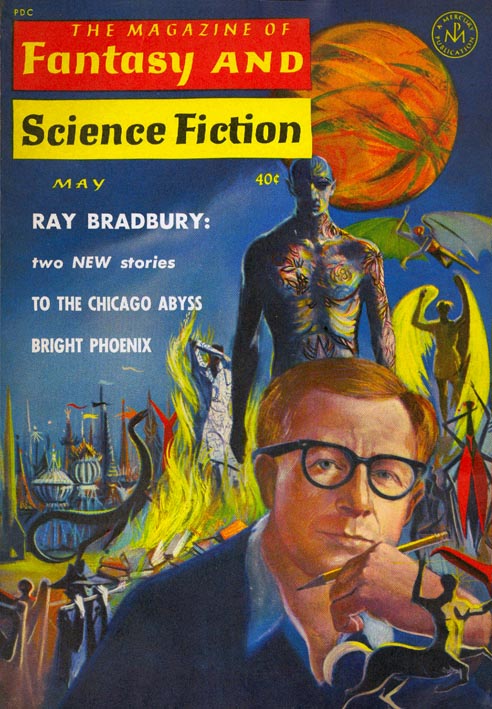
Bradbury: Prose Poet in the Age of Space, William F. Nolan
Bradbury's Boswell is a minor SF writer, fairly recent to the scene. Nolan became pals with Ray in his fandom days in the early '50s, and he is sufficiently versed with Bradbury's career to write a perfectly fine biography. Worth reading. Four stars.
Bright Phoenix, by Ray Bradbury
F&SF editor Davidson has apparently persuaded Ray to part with a couple of pieces of "desk fiction" — stuff that didn't sell, but which now has value since the author is famous. Phoenix is the original version of The Fireman, set at the beginning of the government campaign to burn seditious (i.e. all) books. The Grand Censor's efforts are thwarted by the grassroots project whereby library patrons take it upon themselves to memorize the contents of the books, thus preserving the knowledge.
It's a mawkish, overdone story, but at the same time, it accomplishes in less than ten pages what it took Bradbury more than a hundred to do in his later book. Had I not known of The Fireman, and had I read this in 1948 (when it was originally written), I might well have given it four stars. As it is, it's redundant and a bit smug. Three stars.
To the Chicago Abyss, Ray Bradbury
This longer piece is a variation on the same theme. An old man, one of the few who remembers a pre-apocalyptic past, continually runs afoul of the authorities by recounting fond memories to those who would vicariously remember a better yesterday. It's another story that pretends to mean more than it says, but doesn't. Three stars.
An Index to Works of Ray Bradbury, William F. Nolan
As it says on the tin — an impressive litany of Bradbury's 200+ works of fiction. Look on his works, ye Mighty, and despair.
Mrs. Pigafetta Swims Well, Reginald Bretnor
From the writers of the increasingly desperate Ferdinand Feghoot puns comes an amusing tale of an opera-singer bewitched by a jealous Mediterranean mermaid. Told in a charming Italian accent, it is an inoffensive trifle. Three stars.
Newton Said, Jack Thomas Leahy
New authors are the vigor and the bane of our genre. We need them to carry on the legacy and to keep things fresh. At the same time, one never knows if they'll be any good, and first stories are often the worst stories (with the notable exception of Daniel Keyes' superlative Flowers for Algernon).
So it is with Jack Thomas Leahy's meandering piece, built on affected whimsy and not much else, of the face-off between a doddering transmogrifying elf and his alchemically inclined son. One star.
Underfollow, John Jakes
This one's even worse. A citizen of Earth, for a century under the thumb of alien conquerors, decides he's tired of the bad portrayal of humans on alien-produced television shows. He tries to do something about it. His attempts backfire. I read it twice, and I still don't get it. I didn't enjoy it either time. One star.
Atomic Reaction, Ron Webb
Deserves a razzberry as long as the poem. Two seconds should suffice. One star.
Now Wakes the Sea, J. G. Ballard

British author Ballard has a thing for the sea (viz. his recent, highly acclaimed The Drowned World). This particular story starts out well, with a man, every night, dreaming of an ever-encroaching sea that threatens to engulf his inland town. It's atmospheric and genuinely engaging, but the pay-off is disappointing. Colour in search of a plot. Three stars.
Watch the Bug-Eyed Monster, Don White

Don White has a taste for the satirical. Here, he takes on stories that start like, "Zlat was the best novaship pilot in the 81 galaxies," by starting his story with, "Zlat was the best novaship pilot in the 81 galaxies." The problem is, a satire needs to say something new, not just repeat the same badness. One star.
Treaty in Tartessos, Karen Anderson
Now things are getting better. In Ancient Greece, the age-old rivalry between humans and centaurs has reached an unsustainable point, and an innovative solution is required. A beautifully written metaphor for the conflict between the civilized and the pastoral whose only flaw is a gimmicky ending. Four stars.
Just Mooning Around, Isaac Asimov

The Good Doctor presents a most interesting piece on the tug of war over moons between the sun and its planets. The conclusion, in which the status of our "moon" is discussed, is an astonishing one. Five stars.
No Trading Voyage, Doris Pitkin Buck
A lovely piece on the troubled trampings of a dispossed starfaring race called humanity. Four stars.
Niña Sol, Felix Marti-Ibanez
The Brazilian author who so impressed me a few months back has returned with an even better tale. Writing in that poetic, slightly foreign style that one only gets from a perfectly fluent non-native speaker, Mr. Ibanez presents us a love story set in Peru between an artist and a Sun Elemental. Beautiful stuff. Maybe Bradbury should go to Rio for a few years. Four stars verging on five.
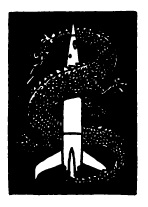
If you're a Bradbury fan, then the emotional and fantastic character of this month's issue will greatly appeal to you. And even if you're not, there's enough good stuff at the ends to justify the expenditure of 40 cents.
[February 24, 1963] Something Old, Something New (March 1963 Fantastic)
[While you're reading this article, why not tune in to KGJ, Radio Galactic Journey, playing all the current hits: pop, rock, soul, folk, jazz, country — it's the tops, pops…]

by Victoria Silverwolf
The pace at which innovations are arriving in these modern times is dizzying. This month alone, a remarkable array of novel products appeared:
A new commercial aircraft, the Boeing 727, made its first flight. It differs from the earlier 707 in having three jet engines rather than four. Intended for short and medium-length flights, it can use shorter runways at smaller airports than the older model requires.

The Coca-Cola Company introduced Tab, a new diet soft drink, in competition with Royal Crown Cola's Diet Rite. An IBM 1401 computer generated more than 185,000 four-letter words containing one vowel as possible names for the product. The winning name, shortened from "tabb,"sometimes appears as "TaB," with the first and last letters capitalized.

The Feminine Mystique is a recently published book by Betty Friedan that may lead to a new women's movement, similar to the fight for voting rights in the early years of this century. It challenges the idea that the most fulfilling roles for American women are as housewives and mothers.
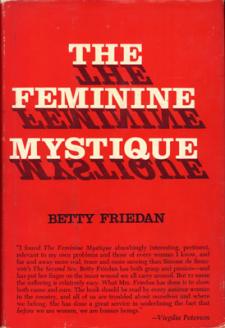
While we welcome all these new things, we should also remember the old. Telstar 1, which now seems like a part of history, although it launched only seven months ago, has ceased operating. Radiation in the Van Allen belt destroyed its delicate circuitry.

Popular music also featured a mixture of old and new in recent weeks. Earlier this month, Walk Right In by the Rooftop Singers reached the top of the charts. Many listeners may not have realized that this catchy folk song is a remake of a tune first recorded by Cannon's Jug Stompers way back in 1929. This revision of an old song yielded the Number One position later in the month to something brand new, Hey Paula, as sung by a duo calling themselves Paul & Paula. In my opinion, this is a case where newer isn't better.
Fittingly, half the stories in the latest issue of Fantastic appear in print for the first time, while the other half date back to the previous century.

Physician to the Universe, by Clifford D. Simak

One of the biggest names in science fiction begins his most recent story in a mysterious fashion. A man awakes in a dark place with little memory of his past. Little by little, he remembers what happened to him. This is a future world where robots enforce strict health regulations. The man's crime is failing to take care of himself. His punishment is exile to an island in the middle of a vast swamp. With two fellow prisoners, he undertakes the long and dangerous journey across the wilderness to freedom. Slowly, he recalls the extraordinary thing that happened to him as a child, and the important reason he must return to his home. This is a complex story, told with multiple flashbacks. Some scenes are full of lyrical beauty. One might quibble that the ending is sudden, and that the author makes use of too many speculative themes for a story of this length, but overall it's compelling. Four stars.
A Question of Re-Entry, by J. G. Ballard

A major British author offers a science fiction version of Joseph Conrad's Heart of Darkness in his latest story. A United Nations official travels deep into the South American jungle in search of a spacecraft that crashed there five years ago. He finds a tribe of Indians ruled by a white man who knows more about the missing vehicle than he admits. Ballard has a gift for vivid description, and the jungle setting truly comes to life. The plot is less effective, but adequate. Three stars.
An Apparition, by Guy de Maupassant
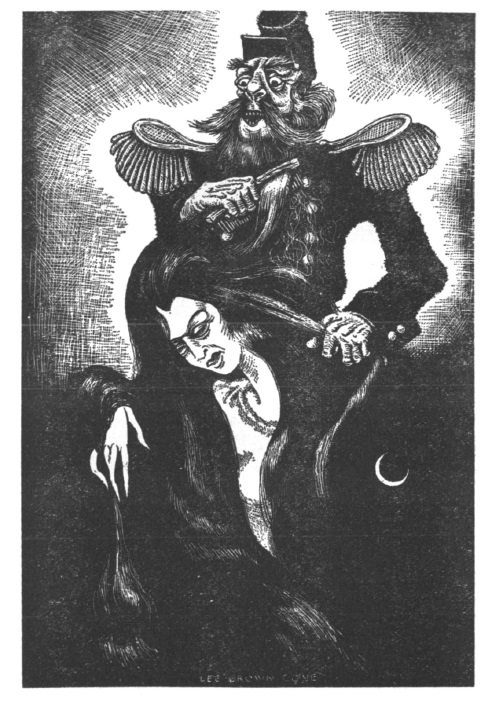
We begin a trio of reprints with this 1883 story, translated from French. An elderly man recounts the ghostly encounter he experienced as a young soldier. There's not much else to this tale of the supernatural, which is really just an anecdote. Two stars.
The Wet Dungeon Straw, by Jean Richepin

Also from 1883, and also translated from French, this macabre little story involves a man held prisoner for decades. He becomes obsessed with drying out the wet straw on which he lies, exposing each piece to the tiny bit of sunlight he receives each day. This project takes many years, and leads to an ironic conclusion. Three stars.
His Natal Star, by Austyn Granville
This bagatelle from 1891 features an astronomer as its protagonist. The star under which he was born draws near the solar system, and its gravity causes him to be drawn toward it. The only purpose of this bit of absurd science is to show the fellow floating upside down in his home. One star.
Nine Starships Waiting, by Roger Zelazny
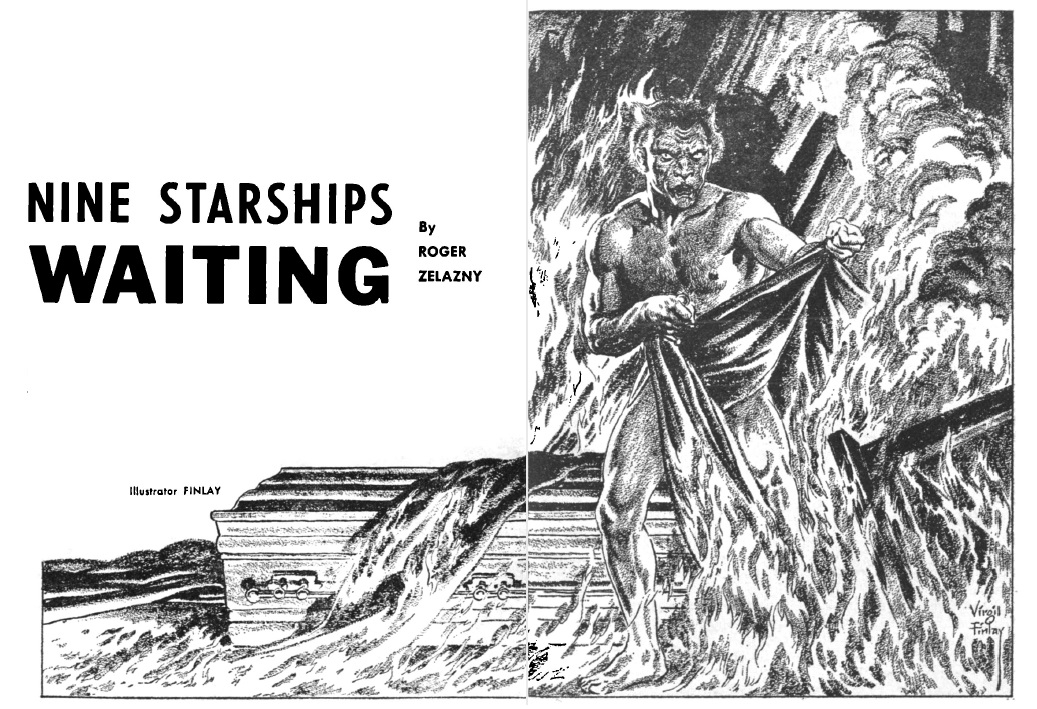
We return to new fiction with the longest story yet from this prolific young writer. It's difficult to offer a synopsis of this confusing tale. Suffice to say that a super-assassin is sent to prevent a fleet of spaceships from conquering a planet. The story is told from multiple viewpoints, and the assassin undergoes a strange change of identity, so the plot is difficult to follow. The story is overwritten at times, with many literary allusions. Two stars.

This disappointing issue, with a few bright spots, proves that both the old and the new contain good and bad.
[P.S. If you registered for WorldCon this year, please consider nominating Galactic Journey for the "Best Fanzine" Hugo. Your ballot should have arrived by now…]
[February 12, 1963] HOPE SPRINGS (the March 1963 Amazing)
[If you live in Southern California, you can see the Journey LIVE at Mysterious Galaxy Bookstore in San Diego, 2 p.m. on February 17!]

by John Boston
Well, hope springs eternal, and a good thing for certain SF magazines that it does. The March Amazing has a rather distinguished table of contents: a novelet by John Wyndham and short stories by veterans Edmond Hamilton, H.B. Fyfe, and Robert F. Young and up-and-comers like J.G. Ballard, rising star Roger Zelazny, and variable star Keith Laumer.

But we must temper optimism with realism: since Amazing is about the lowest-paying of the SF magazines, top-market names are probably here with things they couldn’t sell elsewhere. So, prepared for all eventualities . . .

Edmond Hamilton’s Babylon in the Sky is a simple morality tale for SF fans. Young Hobie lives in the sticks, where there are no jobs and people survive on doles and make-work, seldom make it past the eighth grade, and resent eggheads and know-it-alls—especially the decadent ones in the orbiting cities that Hobie’s preacher father rails against. So Hobie runs away to the spaceport and stows away to one of these satellites, planning to sabotage the power plant and blow it up. He doesn’t get far, and the sane and reasonable people there explain to him that they are not living sybaritic lives but working hard at research to benefit everyone. We didn’t rob you, Hobie, the home folks did. So they’re just sending him back, but Hobie, you’re a smart kid, if you go to the Educational Foundation near the spaceport, they’ll take care of you, and then maybe you can join up and come back here. Hobie buys it. Well, yeah, that’s more or less my life plan too if I can swing it, but I don’t read SF for homilies even if I agree with them. It’s slickly enough done, but two stars for unearned propagandizing.

Speaking of slick, here’s Robert F. Young again. When last he appeared, I said he “knows so many ways of being entirely too cute,” and boy howdy was I right. In Jupiter Found, the protagonist’s brain, after an auto accident did for the rest of him, is installed in a giant mining and construction machine on Jupiter—a M.A.N. (Mining, Adapting Neo-Processor), model 8M. He is shortly joined by model EV, who is of course a W.O.M.A.N. (Weld Operating, Mining, Adapting Neo-Processor). They work for Gorman and Oder Developments, which has strictly forbidden them to process an ore called edenite, and they’ve also been warned to beware of a guy who has been cast out of a high place in the company and is now in business for himself, who will be sending down a mining unit called a Boa 9. By this point in Young’s arch and labored rendition of the Old Testament I was thinking longingly of some of the more bloodthirsty passages in Leviticus. One star. What kind of rubes does this guy think he’s writing for? Even Hobie wouldn’t go for this.

John Wyndham is best known for his chilly novels of the 1950s, from The Day of the Triffids to The Midwich Cuckoos, less so for Trouble with Lichen (1960), intelligent and readable but much less incisive than its predecessors. His novelet Chocky is unfortunately in the latter vein. The protagonist’s kid seems to be having conversations with an imaginary friend, except anybody who’s read a lick of SF will know immediately that he’s communicating with an extraterrestrial intelligence. So we get the worried parent routine, and the marital tension, and the visit from the child psychologist friend, the rather subdued climax, and then . . . some explanation and it all goes away. The whole 38 pages worth is so low-key as to be near-comatose. One wonders if Wyndham is taking some of the new tranquilizers that psychiatrists hand out these days. It’s benignly readable but there’s not much to it. Two stars.

Roger Zelazny’s short The Borgia Hand is livelier but insubstantial, about a young man with a withered hand in generic fairy-tale country who chases down a pedlar (sic) reputed to traffic in body parts. Yeah, he’s got a hand in stock, and here’s a quick gimmick and it’s over. Two stars. Snappy writing is nice, but as one noted critic put it, where’s the bloody horse?

But relief is in sight. There’s nothing especially original about Keith Laumer’s The Walls: future overpopulated Earth with people living regimented lives stuffed into tiny spaces in big apartment complexes; protagonist’s husband is on the make and brings home a Wall, i.e. a TV screen that covers one wall. You can turn it off but then you’ve got a wall-sized mirror. Next, another Wall; then another; then . . . . The story is the wife’s psychological disintegration stuck all day with a choice of all-directions TV-land or a hall of mirrors, but—as with It Could Be Anything from a couple of issues ago—Laumer’s knack for concrete visual detail brings it off and keeps it from being a print version of one of those lame Twilight Zone episodes which end with somebody going crazy. Four stars.

J.G. Ballard is back with The Sherrington Theory, his most minor effort yet in the US magazines. Protagonist and wife are at a beach cafeteria terrace, watching the remarkably dense beach crowd (no sand visible), and intermittently discussing the theory of Dr. Sherrington that the imminent launch of a new communications satellite will trigger certain “innate releasing mechanisms” in humans, which of course it does. This one frankly reads a bit like a self-parody; in fact, the idea is a sort of domesticated knock-off of the one he developed much more effectively in The Drowned World. Of course it’s written with Ballard’s usual flair (or mannerisms, as you prefer), e.g.: “. . . this mass of articulated albino flesh sprawled on the beach resembled the diseased anatomical fantasy of a surrealist painter.” The situation is more skillfully developed and built up than in Zelazny’s story, bringing it up, barely, to three stars.

The stars hide their faces as we come to H.B. Fyfe’s Star Chamber, a shameless Bat Durston in which a parody of a despicable criminal has crash-landed on an uninhabited planet and a lone lawman has come after him. It reads like something Fyfe couldn’t sell to Planet Stories until the mildly clever end, which reads like something he couldn’t sell to Analog because they were overstocked on Christopher Anvil. Two stars, barely.

And here is earnest Ben Bova with Intelligent Life in Space. Haven’t we seen this already? Not quite—this time he’s going on about the definition of intelligence, touching base at ants, dolphins, and chimpanzees, and suggesting that we’re not likely to find it in the Solar System but likely will do so farther away. This one is a more pedestrian rehash of familiar material than most of his earlier articles. Two stars.

So: one very good story, one amusing one, and downhill—pretty far downhill—from there. Hope may spring eternal, but one takes what one can get.
[P.S. If you registered for WorldCon this year, please consider nominating Galactic Journey for the "Best Fanzine" Hugo. Your ballot should have arrived by now…]
[February 6, 1963] Up and Coming (March 1963 IF Science Fiction)
[If you live in Southern California, you can see the Journey LIVE at Mysterious Galaxy Bookstore in San Diego, 2 p.m. on February 17!]

by Gideon Marcus
I've complained from time to time about the general decline in quality of some of the science fiction digests, namely Analog and Fantasy and Science Fiction. On the other hand, Cele Goldsmith's mags, Amazing and (particularly) Fantastic have become pretty good reads. And IF is often a delight. Witness the March 1963 issue. Not only does it have a lot of excellent stories, but the new color titles and illustrations really pop.
Speaking of which, Virgil Finlay provides most of the pictures in this issue. While I think he's one of the most talented artists in our genre (I gave him a Galactic Star last year), I find his subject matter increasingly dated. His pieces would better fit a magazine from the 40s.

The Time-Tombs, by J. G. Ballard
The Egyptians entombed their notables such that they might enjoy a rich and comfortable afterlife. But what if they had preserved them with the intention of eventual resurrection? Ballard's tale features a trio of grave robbers — pirate-archaeologists who plunder tombs containing the digitized remains of the long-dead. Each has their own motivations: scholarship, profit, romance. Taken too far, they lead to ruin. Ballard's tales tend to be heavy, even plodding. There's no question but that he's popular these days, and his stuff is worth reading. It's just not strictly to my taste. Three stars.
Saline Solution, by Keith Laumer
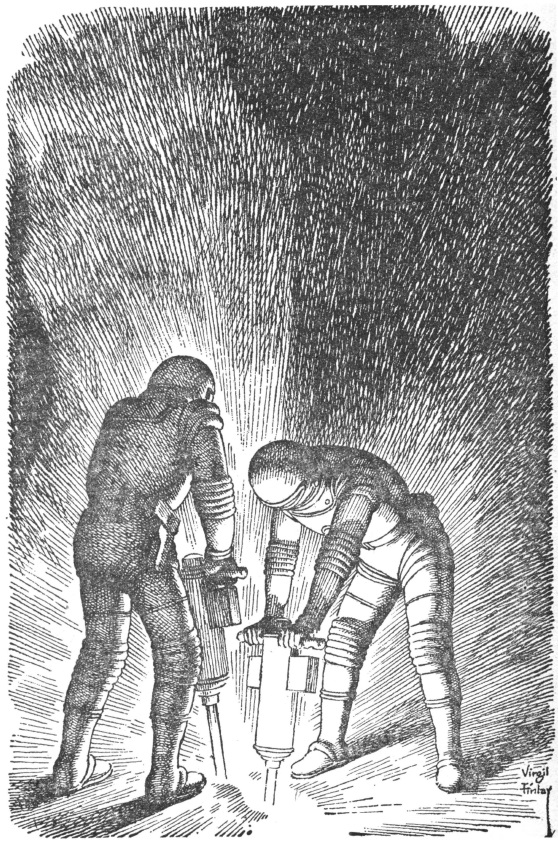
My correspondence with the Laumer clan (currently based in London) continues, but I'd enjoy his work regardless. The cleverly titled Saline Solution is one of my favorite stories involving Retief, that incredibly talented yet much put-upon diplomat/superspy of the future. It's also the first one that takes place in the Solar System. Four stars.
The Abandoned of Yan, by Donald F. Daley
Daley's first publication stars an abandoned wife on an autocratic world. It's a bleak situation in a dark setting, and I wasn't sure if I liked it when I was done. But it stayed with me, and that's worth something. Three stars.
The Wishbooks, by Theodore Sturgeon
Sturgeon's non-fiction piece this month is essentially a better, shorter version of the article on technical ads in last month's Analog. Three stars.
The Ten-Point Princess, by J. T. McIntosh
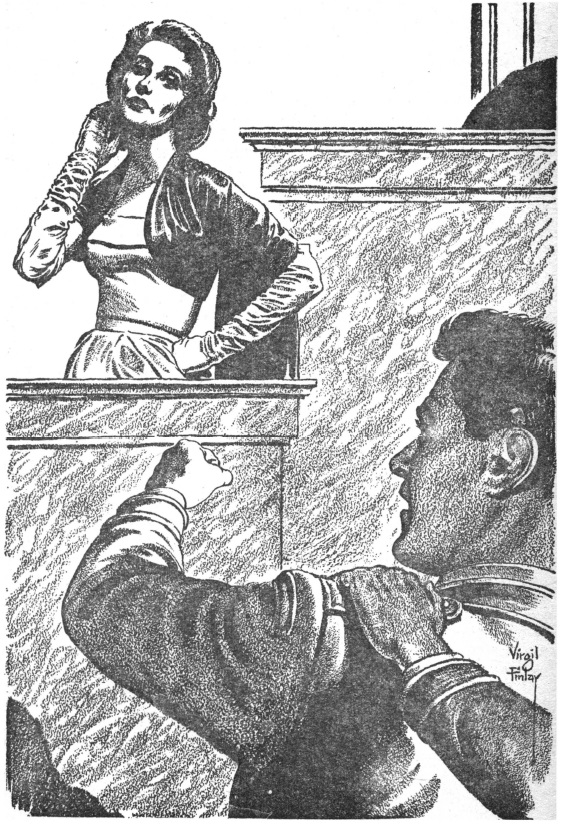
A conquered people deprived of their weapons still find clever ways to resist. When a Terran soldier kills his superior over an indigenous girl, is it justifiable homicide? Self defense? Or something much more subtle? It's up to an Earthborn military lawyer to find the truth. This is a script right out of Perry Mason with lots of twists and turns. Four stars (and I could see someone giving it five).
Countdown, by Julian F. Grow
Someday, our nuclear arsenals will be refined to computerized precision and hair-trigger accuracy. When that happens, will our humanity be sufficient to stop worldwide destruction? The beauty of this story is in the presentation. I read it twice. Four stars.
Podkayne of Mars (Part 3 of 3), by Robert A. Heinlein

At last, Heinlein's serial has come to an end. It only took five months and three issues. Sadly, the plot was saved for the last third, and it wasn't worth waiting for. Turns out Poddy's trip to Venus wasn't a pleasure cruise, but rather served as cover for her Uncle's ambassadorial trip. Two unnamed factions don't want this trip to happen, and they pull out all the stops to foil his mission. Overwritten, somewhat unpleasant, and just not particularly interesting. Two stars for this segment, and 2.67 for the aggregate.
Between this and Stranger in a Strange Land, has the master stumbled?
I, Executioner, by Ted White and Terry Carr
Last up is a haunting piece involving a mass…but intensely personal execution. Justice in the future combines juror and deathdealer into one role. Excellent development in this short tale. Four stars (and, again, perhaps worthy of five).

That comes out to eight pieces, one of which is kind of a dud, and four of which are fine. I know I plan to keep my subscription up.
Speaking of subscriptions, drift your eyes to the upper right of this article and note that KGJ is now broadcasting. Playing the latest pop, rock, mo-town, country, jazz, folk, and surf — and with not a single advertisement — I expect it to be a big hit from Coast to Coast… and beyond. Tune in!
[P.S. If you registered for WorldCon this year, please consider nominating Galactic Journey for the "Best Fanzine" Hugo. Your ballot should have arrived by now…]
[December 28, 1962] Braving the Cold (January 1963 New Worlds)
[if you’re new to the Journey, read this to see what we’re all about!]

by Mark Yon
I hope you’ve all had a good Christmas. Here in Britain it has been…. interesting. As fellow traveller Ashley has mentioned, the cold and foggy weather has now turned into a fully-fledged Winter of ice and snow. As I type this, snow has been falling all over the UK in great amounts for a couple of weeks, and is showing no sign of stopping. The result has been chaos. The news is filled of stories about villages being made inaccessible and even in the urban areas, such as the Northern provincial city I live in, travel has been treacherous. The Met Office is telling us that it is “The Big Freeze”, and may be the worst winter weather in decades. Even if it is not, it certainly feels like it!
Anyway, enough of the weather.
As I said I would, I have braved the Winter cold to go to the cinema since we last spoke, and I am pleased to say that I whole-heartedly recommend Mr. David Lean’s Lawrence of Arabia, despite its length. I saw the movie in two parts, with an intermission. At a run-time of just under four hours I was not bored for one moment. It is one of the best-looking movies I have ever seen, and I loved the majestic score by Mr. Maurice Jarre, so much so that I am now looking for a copy of the movie soundtrack to play on my record player. As it is mainly set in the desert, though, it might just be what’s needed to keep the Winter chill out!

This month’s New Worlds shows a cover that’s back to the lurid. This month, it is an unsubtle Day-Glo shade of Santa Claus red. It heralds the return of a story by Mr Lan Wright after his stint as guest Editor last month. This is the first time that Mr. Wright has had an actual story in the magazine since February 1959. It is the first of three parts. More on this later.
I Like It Here, by Mr. David Rome

We begin with a short guest editorial from Mr. Rome – his fourth appearance in New Worlds in as many consecutive months, which suggests that he is a popular choice, by the editors, and (one hopes) the reading public. [David is also quite popular with the Journey, having recently engaged in written correspondence with us. It is he who provided the picture above. (Ed.)]
Mr Rome is a relative newcomer to s-f and as a result has a rather refreshing viewpoint upon professionalism in the genre here. It is the latest foray into the ongoing battle between the prevalent issue in British s-f – should it be populist entertainment but written by amateurs, or more specialist and challenging, with professional leanings? Mr. Rome’s take on it is that, as a relative newcomer, the s-f writer is motivated by a belief in the genre rather than by money. As a result, an acceptance of s-f by the mainstream, in his opinion, would lead to dissolution and a loss of the thing that makes s-f great. It’s an intriguing point of view, rather similar to that anti-professional stance given by Mr. Wright as editor last month.
Which leads us to:
Dawn’s Left Hand, by Mr Lan Wright.
The title’s a good one (a quote from the Rubaiyat of Omar Khayyam) but despite such lofty ambitions, the actual story shows its amateur origins by being rather uneven in tone and pace. I must admit that I was rather disappointed by the story. The plot is admittedly fast-paced, in an old-fashioned pulp style, but like many of the old-style stories of the Golden Age, if you actually stop to think about it, the plot has no logic. It is entertaining, but really doesn’t hold much water. As expected, the story ends on a cliff-hanger, to be continued next issue. I hope that it improves. Two out of five.
Ecdysiac, by Mr. Robert Presslie
This story marks the return of another regular New Worlds writer. His last was Lucky Dog in the November 1962 issue, which I thought was disappointing. This was better, an espionage tale that adopts the use of psionics in ways that I imagine Mr. Poul Anderson and Mr. A. E. van Vogt would. The dour ending is typically British, though! Three out of five.
The Big Tin God, by Mr. Philip E. High
Another regular New Worlds writer, last read with The Method in the November 1962 issue, which I was not enormously impressed by. This one is, thankfully, better. It’s a story of city-states, and a secret war that leads to the creation of an artificial intelligence capable of independent thought. The short story held my attention, although the twist at the end was a little predictable and, if I dare say it, even arrogant in its presumption. Two out of five points.
Burden of Proof, by Mr. David Jay
Mr. Jay gives us a story of hate and murder, placed within a futuristic mystery and a possibly mistaken accusation. It’s nicely done but the denouement depends on a hook that’s not too convincing. Again, two out of five.
The Statue, by Mr. R. W. Mackelworth
After a number of well-known authors, it’s great to have a new one. Mr. Mackelworth’s The Statue is a worthy debut as a short story about a mysterious artefact and its effect on a group of explorers. There’s an interesting use of telepaths in the tale but it is let down by some standard (and rather predictable) stereotypes. Three out of five.
The Subliminal Man, by Mr. J. G. Ballard
Although Mr. Lan Wright has the biggest billing, here is the best story in the magazine, from another initialled author, the much-welcome Mr. J. G. Ballard. We don’t see enough of Mr. Ballard’s work these days in New Worlds, and it is noticeable how good it is when compared with the rest. It is also miles away from the traditional s-f that we expect. A dystopian tale of the future consequences of incessant advertising and relentless consumerism, its sense of paranoia is both chilling and effective. Four out of five.

Lastly, there’s the usual Book Review by Mr. Leslie Flood. There is only one recommendation this month albeit a wholehearted one and a collection you already have in the US – A Decade of Fantasy and Science Fiction, edited by Mr. Robert P. Mills.

As recent issues of New Worlds go, this one feels stronger, even if the quality of the stories varies somewhat. The return of Mr. J.G. Ballard raises the bar a little and makes me feel a little more positive for the future of the magazine than I have been lately.
And with that hint of optimism, until next time, it just remains for me to wish you all the best for 1963.
[P.S. If you want the chance to nominate Galactic Journey for Best Fanzine next year, you need to register for WorldCon before the end of the year! (or have registered last year… but then you can only nominate, not vote.) The Journey will be at next year's WorldCon, so don't miss your chance to meet us and please help put us on the ballot for Best Fanzine!]
[July 4, 1962] Happy submersion (The Drowned World, by J.G. Ballard)

by Rosemary Benton
At last, the levity that I so desperately needed has been provided. Prior to reading The Drowned World I was only aware of J. G. Ballard as a name. He was well published, I knew, but ultimately a background figure to my science fiction library. That all changed on June 30th, however, when I went to the town bookstore and purchased The Drowned World. The bookseller said that it would take me no time at all to read. I found this to be true, although the time it took me to process the book was far longer than than I had expected.
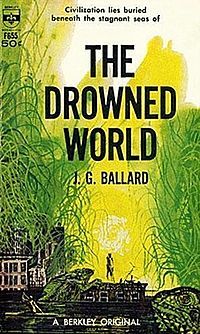
J. G. Ballard's The Drowned World is a post-apocalyptic ballad performed by a select cast, and encased in a small slice of Ballard's much larger story of the evolution of Earth. The location of the story takes place in an entirely fictional future vision of Earth. Due to a sun which has become unstable, the Earth is rapidly heating. The remaining 5 million humans have fled to the Antarctic circle where the temperature is a tolerable 85 degrees. The Earth's equator, by comparison, is close to 200 degrees on any given day. Bombarded by solar radiation and spurred on by the intolerable heat, flora and fauna have begun to mutate to prehistoric shapes and sizes. Enormous iguanas, crocodiles and snakes are now a common site in Berlin and London, whose streets and buildings are now submerged by upwards of 50 feet of water. Large bat-sized mosquitoes bash themselves relentlessly against the wire meshes and cages encircling the last human bastions in London, while dog-sized bats feast upon the oversized insects. The evolution of disease has kept pace with the changing environment; malaria becomes the most common affliction hitting the human population.
Much of Europe has been reduced to lagoons nestled between vast expanses of jungle and silt dunes. In one such lagoon, floating over the decaying architecture of London, sits the stage and players of the story. Central to the book are the biologists Dr. Robert Kerans and Dr. Bodkin, the emotionally distant heiress Beatrice Dahl and the villainous looter, Strangman. Surrounding them are the rest of the research team sent to monitor the changing landscape, and Strangman's crew of tribalistic-minded followers.

On a small scale Ballard includes the traditional elements of science fiction and action-adventure. There is a hero, a villain, a love interest who is desired by both the villain and the hero, a climax to the tension between the battle of the hero and the goals of the villain, tied off nicely with a sacrificial confidant and companion to the hero. On a much larger scale The Drowned World offers a character study of a villain and a hero, both of whom are morally ambiguous, as they navigate a truly alien environment with totally different sets of rules for survival.
To best dissect The Drowned World I think it is necessary to take a look at the three major players to Ballard's drama: Ms. Dahl, Strangman and finally Dr. Kerans. Ms. Dahl is perhaps one of the more developed characters of the story, and yet her journey is largely symbolic. A key element of Ballard's world is that not only is the physical world around humanity devolving, but so is the unconscious mind of humanity. Plagued by memories of survival urges now unlocked after centuries of culture and socialization, humans by and large are subjected to nighttime visions of hot, fiery landscapes and looming reptilian danger. Ms. Dahl is one of the first characters who we see suffering from these apparitions.
We read about her trying to deal with them through alcohol and cool detachment. Her acceptance of the end of the human world is made all the more evident by her refusal early on in the book to leave the lagoon for the more tolerable temperature of the northern settlements. Despite the coming rains, the rise of the water, and the abandonment of the post by the well equipped scientific team, she shows little interest in leaving behind her home. Yet in the shifting pools of green, warm water with its surface disturbed by the movement of reptiles swimming in and out of the lower levels of the ruined buildings, she has managed to find an equilibrium in which she can live out her days, even as the prophetic nightmares of flooding rain and dense jungle encroachment press ever closer. She has given up fighting against nature and the universe's larger plans for the planet, and instead finds her small pleasures in dining on the dwindling reserves of fine food, sunbathing, and keeping up a cultured outward physique.
Ms. Dahl's personal journey is taking her along the same path as Dr. Kerans'. She is dreaming of an ancestral life and living it as best she can in the present. When confronted with a challenge to this backwards slide she recoils and withdraws within herself. She longs for the return to the encroachment of the water and reviles in the exposure of the land. She is unable to deal with change that could draw her on a different path from the envelopment of Earth by the sea, and ultimately it destroys her relationship with her companions Dr. Kerans and Dr. Bodkin.

Enter Strangman on his ridiculous riverboat piled high with looted objet d'art, liquor and jewelry. Like Ms. Dahl, Strangman enters the story as someone who has given in to the changing world, although he has done so in a drastically different fashion. In keeping with salvage laws and the overall objective of land reclamation, Strangman drains the lagoon in order to gain favor with the loosely upheld government. At the same time he is able to continue with his passion of surrounding himself with items of beauty from the old world. Unlike our protagonists, Strangman is not regressing backwards to a state of piteous apathy, nor is he embracing the larger time scale that Ms. Dahl and Dr. Kerans have via their million year old primitive dreams. Even though he is aware of them via conversation with Dr. Kerans, and presumably experiences them himself, he is written as an opportunist. He takes risks in sending his crew, which he provides for and never once abuses, down into the sunken city. He takes chances by draining the lagoon in order to reclaim the land and thereby more easily take its sunken riches. He is progress in a backwards way because ultimately nothing he does will have any lasting impact, but he at least fights against the insignificance of his actions and his existence.
Along this line he is also upholding the pre-drowned world, and while he revels in the finer luxuries it provided, he doesn't do so in the same way as Dr. Kerans or Ms. Dahl. While they are content with living out the lifespan of their delicious foods and luxury accommodations before the sea reclaims them, Strangman wants to make them last as long as possible. Even unnaturally so. He rejects the inevitable in favor of the possible when he drains the lagoon and likely plans to drain others in the area. He is even commended for his actions by Dr. Kerans' team when they return to the area at the end of the book and see what he has accomplished.
At last we must examine Dr. Kerans. This man, who we meet standing on his balcony of the Ritz complete with air conditioning, fine clothes and even finer furnishings, is not shaken by the thought of nearly anything involving his future. Absorbed in the visceral feel of his present environment, Dr. Kerans is a man who lives entirely in the now with little thought to the future or concern for the past. Only later does he even begin to experience the dreams that have led most of the cast to a delayed madness. At the end of the book he even embraces a futile journey south and consequently a slow, painful suicide. Put concisely he is against everything that we, as modern humans and Americans, are taught to embrace as progress – the continuous struggle against nature, the need to suffer for progress, and the need to forge your own fate. In any other story he would be the villain trying to prevent the human race from fighting back against its aggressor. Interestingly, in this story he is the hero. But why is he the hero? Ultimately I believe this can be answered by Ballard's writing style.

J. G. Ballard's writing is like a good red wine. It has body, heft, and layered flavors that reveal themselves based on how you indulge in them. I read The Drowned World over the course of several days, taking my time to sink into the atmospheric environment that Ballard creates. In short sips the book takes the reader a long way. So many descriptive analogies, metaphors and adjectives are crammed into each page that one would think Ballard had gone overboard. Yet despite his verbose world building, nothing felt repetitive and frankly, I couldn't get enough.
I lived for days on how Ballard would express his characters' wonder at the world surrounding them, and how each as an individual would contribute to the progress of the story. It is this individual experience that I believe made Dr. Kerans the hero, Strangman the villain, and Ms. Dahl the figurative totem. When one reads Ballard's dialogue it is abundantly secondary to the individual brazen actions taken by each character. This isolation, when a character acts of their own volition outside of what their companions would want or desire, is what Ballard revels in. The individual, whether walking forward or backwards in human evolution, is a lynchpin. What they see, how the environment congeals around them, and how their actions later influence others is paramount to Ballard's The Drowned World.
Thus, Dr. Kerans was the hero because he was willing to press forward into that isolation of standing behind his scientific team, and in the end, the isolation of the journey south toward the epicenter of the heat. Strangman, on the other hand, was nothing without his crew, his treasures or his need to change the world for the benefit of the many. As such he was the villain. It is an interesting reversal, and one which I believe took a cunning mind to pen. I look forward to exploring more of Ballard's works and retroactively swimming through his vast sea of published works. This book deserves a well-earned five out of five stars.
—
(P.S. Don't miss the second Galactic Journey Tele-Conference, July 29th at 11 a.m.! If you can't make it to Worldcon/Chicon III, this is YOUR chance to Vote for the 1962 Hugos!)
[June 23, 1962] Only the Lonely (July 1962 Fantastic)

by Victoria Silverwolf
In this age of Cold War tensions, it's a little disconcerting to discover that the United States made two failed attempts this month to detonate a nuclear warhead in space. The project, whimsically known as Operation Fishbowl, launched Thor missiles from Johnston Island, a tiny atoll in the middle of the Pacific Ocean under the command of the US Air Force. The missiles launched on June 2 (Bluegill) and June 19 (Starfish) had to be destroyed in flight due to technical problems. (Radar lost track of Bluegill, and the Starfish rocket engine stopped prematurely.) Some of the debris from Starfish landed on Johnston Island, potentially contaminating persons stationed on the atoll with radioactive material.

If that weren't scary enough, the three inmates who escaped from Alcatraz a couple of weeks ago are still at large. It's probable that they drowned in San Francisco Bay, but I'd advise those of you who live in the area to keep your doors locked.

Raising the alarm in these troubling times are two newly published documents drawing attention to the problems we face. The left-wing organization Students for a Democratic Society released a manifesto entitled The Port Huron Statement a week ago, promoting universal disarmament and other social and political reforms through non-violent civil disobedience.

(It's interesting to note the cover price is the same as that of the magazine I'll eventually get around to reviewing.)
At the same time, The New Yorker (which costs ten cents less than Fantastic or The Port Huron Statement) published an excerpt from Silent Spring, an upcoming book from marine biologist Rachel Carson which discusses the danger posed to the environment by chemical pesticides.
With all of this depressing news, it's not surprising that a melancholy ballad of loneliness and lost love has been at the top of the charts for the entire month. Ray Charles isn't the first musician to have a hit with Don Gibson's 1958 country song I Can't Stop Loving You — besides Gibson himself, Kitty Wells released a popular version the same year, as did Roy Orbison in 1961 — but his version is by far the most successful. It seems likely that this unique combination of rhythm and blues with country-western will have a powerful impact on popular music.
In keeping with this mood, it's appropriate that many of the stories in the current issue of Fantastic feature characters haunted by loneliness, isolation, and lost love.

The great Emsh provides the cover art for The Singing Statues by British author J. G. Ballard. It takes place in the futuristic resort community of Vermilion Sands, which has already appeared in a handful of Ballard's stories. The narrator is an artist who creates sculptures that produce sound in response to those who view them. (There are also indications that these works of art are somehow grown in the surreal landscape of Vermillion Sands, with its copper beaches and dry sea beds.) A beautiful, wealthy, and reclusive young woman purchases one of his works, believing that it sings to her in a way which perfectly reflects her soul. Unbeknownst to her, however, the artist has actually placed an electronically distorted recording of his own voice inside it. When the recording runs out, he goes to her luxurious home under the pretext of making repairs to the statue, actually placing new recordings within it. His deception leads to unexpected revelations. Ballard writes with a fine sense for imagery. His tales of the decadent inhabitants of Vermillion Sands may not be for all tastes, but they are skillfully rendered works of art. Four stars.

This month's Fantasy Classic is The Dragon of Iskander by Nat Schachner, from the pages of the April, 1934 issue of Top-Notch, a magazine which published adventure fiction from 1910 to 1937.
Things start with a bang, as an archeological expedition in a mountainous region of Chinese Turkestan is attacked by a flying, fire-breathing dragon. Our two-fisted American hero, along with his loyal servant and a couple of suspicious characters, makes his way into the mountains, where he discovers a lost kingdom founded by Alexander the Great. Daring escapes and violent action results, and it's no surprise that a beautiful young woman shows up to stand by the hero's side. This story is typical of old-fashioned pulp action yarns, and certainly moves at the speed of lightning. It's marred by some casual racism (the Chinese character is often called "yellow," and non-Americans are generally cowardly and treacherous) and the fact that the true nature of the dragon isn't terribly convincing. Two stars.
After this tale of an isolated nation, we turn to a story about a lonely individual. A Drink of Darkness by Robert F. Young deals with a man who has destroyed his marriage and ruined his life through alcohol. At the end of his rope, he meets a gaunt man who takes him to a strange land where a journey across a dark plain leads him to a towering mountain. The alcoholic assumes that the gaunt man is Death. During their trek he opens mysterious doors which lead to various times in his past life. He relives the loss of his happiness to the bottle. This is a bleak story, but it offers a glimmer of hope. The true identity of the gaunt man is concealed until the end, although an astute reader may pick up a clue earlier. Whether or not you believe the twist ending is appropriate, you are likely to respond to the story's emotional power. Four stars.
The second half of Poul Anderson's short novel Shield continues the adventures of the fellow who has invented a force field. Held captive by a crime boss, sought by both the Americans and Chinese for the secret of his invention, he receives help from an unexpected source. An extended chase follows at a fast and furious pace. Not quite as interesting as the first half, this section still provides plenty of action and a complex, fully developed character in the aide/mistress of the crime boss, who proves to be another example of the persons suffering from emotional loss in this issue. Three stars.
The people in The Thinking Disease by Albert Teichner have become isolated from each other by their own technology. Robots designed to self-destruct when there is any possibility of harming human beings (with a nod to Isaac Asimov's famous Three Laws of Robotics) somehow change from loyal servants to berserk killers at unpredictable times. Their masters live in fear of leaving their homes. The protagonist discovers a way to project his consciousness outside his body, enabling him to fight off the rebel machines. The explanation for how the robots could hurt people, and the manner in which they can be controlled, is rather disappointing. Two stars.
One Long Ribbon is, I believe, the first published story from Florence Engel Randall. The protagonist is a recently widowed mother with a young son. Her husband was a pilot, stationed at one air base after another, who was never able to give her a stable home. Years before his death, he made arrangements to purchase a house for her in case of his demise. When she moves in, she discovers that the other people living on her street act as if they can't see her. Her son claims that he can't see the children that she sees playing outside. This is a Twilight Zone kind of story with an unexpected explanation for its strange events. Four stars.
Overall, this is a pretty good issue, although I wouldn't recommend reading it alone.


![[September 23, 1963] Small Comforts (October 1963 <i>Fantastic</i>)](https://galacticjourney.org/wp-content/uploads/2018/09/630923cover-541x372.jpg)


